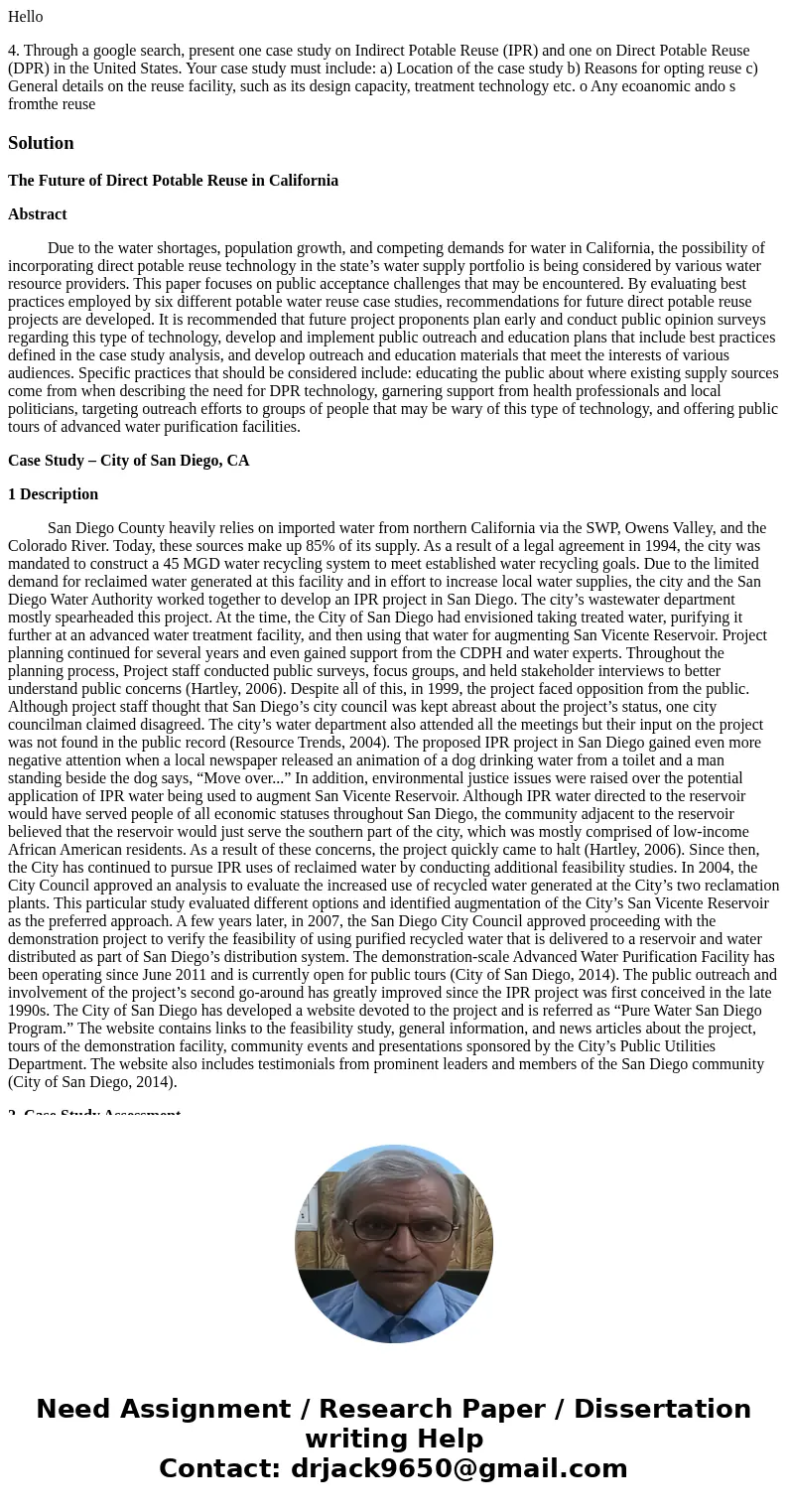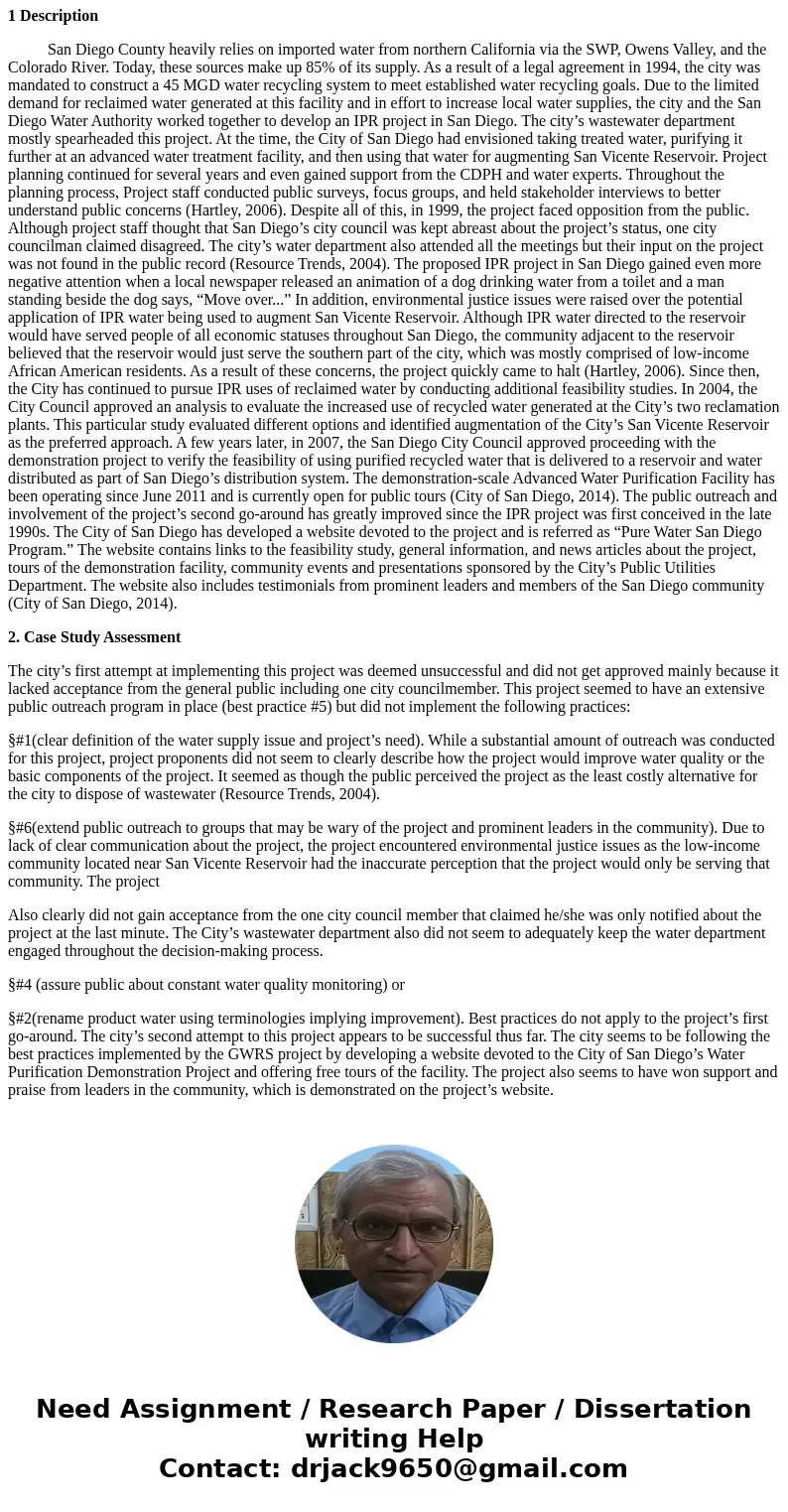Hello 4 Through a google search present one case study on In
Hello
4. Through a google search, present one case study on Indirect Potable Reuse (IPR) and one on Direct Potable Reuse (DPR) in the United States. Your case study must include: a) Location of the case study b) Reasons for opting reuse c) General details on the reuse facility, such as its design capacity, treatment technology etc. o Any ecoanomic ando s fromthe reuseSolution
The Future of Direct Potable Reuse in California
Abstract
Due to the water shortages, population growth, and competing demands for water in California, the possibility of incorporating direct potable reuse technology in the state’s water supply portfolio is being considered by various water resource providers. This paper focuses on public acceptance challenges that may be encountered. By evaluating best practices employed by six different potable water reuse case studies, recommendations for future direct potable reuse projects are developed. It is recommended that future project proponents plan early and conduct public opinion surveys regarding this type of technology, develop and implement public outreach and education plans that include best practices defined in the case study analysis, and develop outreach and education materials that meet the interests of various audiences. Specific practices that should be considered include: educating the public about where existing supply sources come from when describing the need for DPR technology, garnering support from health professionals and local politicians, targeting outreach efforts to groups of people that may be wary of this type of technology, and offering public tours of advanced water purification facilities.
Case Study – City of San Diego, CA
1 Description
San Diego County heavily relies on imported water from northern California via the SWP, Owens Valley, and the Colorado River. Today, these sources make up 85% of its supply. As a result of a legal agreement in 1994, the city was mandated to construct a 45 MGD water recycling system to meet established water recycling goals. Due to the limited demand for reclaimed water generated at this facility and in effort to increase local water supplies, the city and the San Diego Water Authority worked together to develop an IPR project in San Diego. The city’s wastewater department mostly spearheaded this project. At the time, the City of San Diego had envisioned taking treated water, purifying it further at an advanced water treatment facility, and then using that water for augmenting San Vicente Reservoir. Project planning continued for several years and even gained support from the CDPH and water experts. Throughout the planning process, Project staff conducted public surveys, focus groups, and held stakeholder interviews to better understand public concerns (Hartley, 2006). Despite all of this, in 1999, the project faced opposition from the public. Although project staff thought that San Diego’s city council was kept abreast about the project’s status, one city councilman claimed disagreed. The city’s water department also attended all the meetings but their input on the project was not found in the public record (Resource Trends, 2004). The proposed IPR project in San Diego gained even more negative attention when a local newspaper released an animation of a dog drinking water from a toilet and a man standing beside the dog says, “Move over...” In addition, environmental justice issues were raised over the potential application of IPR water being used to augment San Vicente Reservoir. Although IPR water directed to the reservoir would have served people of all economic statuses throughout San Diego, the community adjacent to the reservoir believed that the reservoir would just serve the southern part of the city, which was mostly comprised of low-income African American residents. As a result of these concerns, the project quickly came to halt (Hartley, 2006). Since then, the City has continued to pursue IPR uses of reclaimed water by conducting additional feasibility studies. In 2004, the City Council approved an analysis to evaluate the increased use of recycled water generated at the City’s two reclamation plants. This particular study evaluated different options and identified augmentation of the City’s San Vicente Reservoir as the preferred approach. A few years later, in 2007, the San Diego City Council approved proceeding with the demonstration project to verify the feasibility of using purified recycled water that is delivered to a reservoir and water distributed as part of San Diego’s distribution system. The demonstration-scale Advanced Water Purification Facility has been operating since June 2011 and is currently open for public tours (City of San Diego, 2014). The public outreach and involvement of the project’s second go-around has greatly improved since the IPR project was first conceived in the late 1990s. The City of San Diego has developed a website devoted to the project and is referred as “Pure Water San Diego Program.” The website contains links to the feasibility study, general information, and news articles about the project, tours of the demonstration facility, community events and presentations sponsored by the City’s Public Utilities Department. The website also includes testimonials from prominent leaders and members of the San Diego community (City of San Diego, 2014).
2. Case Study Assessment
The city’s first attempt at implementing this project was deemed unsuccessful and did not get approved mainly because it lacked acceptance from the general public including one city councilmember. This project seemed to have an extensive public outreach program in place (best practice #5) but did not implement the following practices:
§#1(clear definition of the water supply issue and project’s need). While a substantial amount of outreach was conducted for this project, project proponents did not seem to clearly describe how the project would improve water quality or the basic components of the project. It seemed as though the public perceived the project as the least costly alternative for the city to dispose of wastewater (Resource Trends, 2004).
§#6(extend public outreach to groups that may be wary of the project and prominent leaders in the community). Due to lack of clear communication about the project, the project encountered environmental justice issues as the low-income community located near San Vicente Reservoir had the inaccurate perception that the project would only be serving that community. The project
Also clearly did not gain acceptance from the one city council member that claimed he/she was only notified about the project at the last minute. The City’s wastewater department also did not seem to adequately keep the water department engaged throughout the decision-making process.
§#4 (assure public about constant water quality monitoring) or
§#2(rename product water using terminologies implying improvement). Best practices do not apply to the project’s first go-around. The city’s second attempt to this project appears to be successful thus far. The city seems to be following the best practices implemented by the GWRS project by developing a website devoted to the City of San Diego’s Water Purification Demonstration Project and offering free tours of the facility. The project also seems to have won support and praise from leaders in the community, which is demonstrated on the project’s website.


 Homework Sourse
Homework Sourse